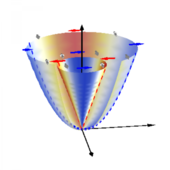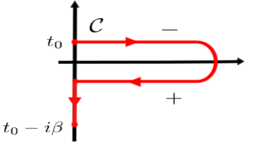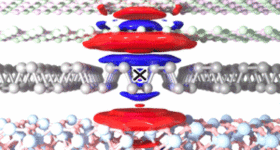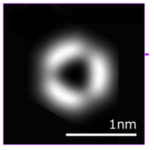Research
Overview
Our group is engaged in research in the fields of computational and theoretical materials science. Our primary focus is the effect of many-body interactions on the excited state properties of a broad range of materials systems, particularly organic and inorganic nanostructures, materials in reduced dimensions and complex functional materials. We develop and apply computational methods to understand and predict the electronic, optical and dynamical properties of these materials from first principles (or ab initio).
Below are some highlights from ongoing research.
Exciton Transport & Diffusion
 Understanding the dynamics and dissociation of photoexcited states is crucial for energy harvesting and conversion and applications of optoelectronic devices. Recent advances in spatially-resolved transient absorption microscopy have allowed researchers to observe exciton diffusion in real-time. The theoretical picture, however, is complicated by the fact that many different processes, such as recombination and exciton-phonon and exciton-exciton scattering, contribute to exciton diffusion. Our group is interested in developing ab initio approaches to study exciton diffusion, transport and dissociation.
Understanding the dynamics and dissociation of photoexcited states is crucial for energy harvesting and conversion and applications of optoelectronic devices. Recent advances in spatially-resolved transient absorption microscopy have allowed researchers to observe exciton diffusion in real-time. The theoretical picture, however, is complicated by the fact that many different processes, such as recombination and exciton-phonon and exciton-exciton scattering, contribute to exciton diffusion. Our group is interested in developing ab initio approaches to study exciton diffusion, transport and dissociation.
Relevant Publications
- Nonanalyticity, Valley Quantum Phases, and Lightlike Exciton Dispersion in Monolayer Transition Metal Dichalcogenides: Theory and First-Principles Calculations
- Signatures of Dimensionality and Symmetry in Exciton Band Structure: Consequences for Exciton Dynamics and Transport
Time-Dependent Phenomena

Relevant Publications
Heterojunctions, Interfaces and Substrates
 The research excitement surrounding layered van der Waals materials lies in part in the ability to peel-off, stack, and manipulate single layers, leading to an endless variety of possible structures and the possibility of tuning materials properties and phases through different stacking, twisting and proximity effects.
The research excitement surrounding layered van der Waals materials lies in part in the ability to peel-off, stack, and manipulate single layers, leading to an endless variety of possible structures and the possibility of tuning materials properties and phases through different stacking, twisting and proximity effects.
Relevant Publications
- Screening and Many-Body Effects in Two-Dimensional Crystal: Monolayer MoS2
- Giant bandgap renormalization and excitonic effects in a monolayer transition metal dichalcogenide semiconductor
- Environmental Screening Effects in 2D Materials: Renormalization of the Bandgap, Electronic Structure, and Optical Spectra of Few-Layer Black Phosphorus
Defects
 Another pathway for engineering optical excitations is through the introduction and control of structural/chemical defects. We found that the electron-hole interaction can result in hybridization of the defect and bulk states, and tuning the defect energy levels can be used to control the degree of hybridization. These defects have potential applications for quantum information, sensing and single-photon emission.
Another pathway for engineering optical excitations is through the introduction and control of structural/chemical defects. We found that the electron-hole interaction can result in hybridization of the defect and bulk states, and tuning the defect energy levels can be used to control the degree of hybridization. These defects have potential applications for quantum information, sensing and single-photon emission.
Relevant Publications
- The role of chalcogen vacancies for atomic defect emission in MoS2
- Rational Passivation of Sulfur Vacancy Defects in Two-Dimensional Transition Metal Dichalcogenides